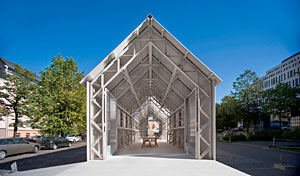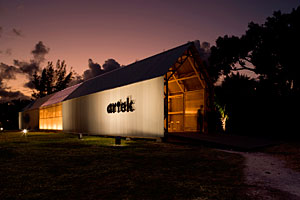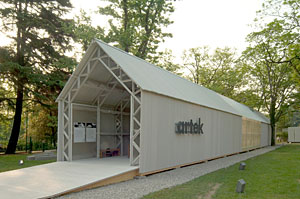


Photo © Rauno Träskelin/courtesy Sotheby’s (top); Michael Stavaridis/courtesy Sotheby’s (middle); Sabine Schweigert/courtesy Sotheby’s (above).
This Saturday, Sotheby’s will auction the 1,991-square-foot, portable Artek Pavilion designed by architect Shigeru Ban. The auction house estimates that bids may exceed $1 million before the gavel closes the sale.
On Saturday, June 14, Sotheby’s will auction the Artek Pavilion designed by architect Shigeru Ban, as part of its semiannual Important 20th Century Design sale in New York. The 1,991-square-foot portable building is being sold on behalf of Artek’s major owner, the Swedish investment firm Proventus, which plans to donate the proceeds to arts and culture charities. “What if Mies van der Rohe’s Barcelona Pavilion had been saved? We are proud to be offering a masterwork that will be studied in future classes of 21st-century architecture,” says James Zematis, senior vice president and head of Sotheby’s 20th Century Design Department. The auction house estimates that the winning bid may exceed $1 million.
The Finnish furniture company Artek was founded in 1935 by Alvar Aalto and three colleagues, and the company has an established history of commissioning pavilions. Ban’s temporary structure was created for Milan’s Salone Internazionale del Mobile that took place in April 2007. After the fair, the building was dismantled and reassembled first in Helsinki and then at Design Miami in Florida. Instead of shipping the pavilion back to Helsinki the company decided to sell it through Sotheby’s.
Ban’s simple, pitched-roof structure is modeled after the Atelier for a Glass Artist he completed in 2006. The Artek Pavilion uses just two shapes for ease of assembly: Decking forms the floor, and angled channels are bolted together to create structural trusses and overlapping roof tiles that form the exterior enclosure. “I love Aalto’s furniture. It is nice to have this connection,“ Ban says.
Just as the architect launched his now-famous paper tube construction technique with the design of an Aalto exhibit held in Tokyo in 1986, this latest Artek assignment is made entirely of a new material composed of recycled plastic and paper. The product of the Finnish paper company UPM, it was developed to reduce waste generated by the manufacture of self-adhesive labels and originally intended for golf tees. Bigger aspirations inspired the fabrication of three architectural shapes, tubes, decking and L-shaped channels, and then the collaboration with Artek. Now Ban is working with Artek on a line of outdoor furniture made of the recycled composite.



Post a comment to this article
Report Abusive Comment